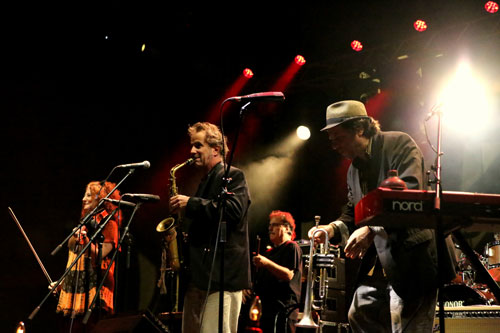Klezmer music is an instrumental tradition that originated with the Ashkenazi Jews in Central and Eastern Europe. The term Klezmer comes from Yiddish, and is a shortened version of the Hebrew words for instrument (kley) and song (zemer).
In the past, a klezmer was a professional male instrumental musician, typically Jewish, who performed in a band hired for special events in Eastern European communities. The genre’s primary components include dance tunes, ritual melodies, and virtuosic improvisations played for listening, which were often performed at weddings and other social gatherings. Klezmer music draws inspiration from Ottoman music, Baroque music, German and Slavic folk dances, and religious Jewish music.
As the music migrated to the United States, it incorporated elements of American big band and popular music. In the 1910s and 1920s, European-born klezmers like Dave Tarras and Naftule Brandwein popularized the genre in the United States. American-born musicians such as Max Epstein, Sid Beckerman, and Ray Musiker followed in their footsteps.
After the destruction of Jewish life in Eastern Europe during the Holocaust and a general decline in the popularity of klezmer music in the United States, the music experienced a resurgence in the late 1970s during the Klezmer Revival. In the 1980s, musicians began experimenting with traditional and experimental forms of the genre, releasing fusion albums that combined klezmer with jazz, punk, Roma (Gypsy) music, and other styles.
The Klezmer Revival in the United States and Europe was led by Giora Feidman, The Klezmorim, Zev Feldman, Andy Statman, and the Klezmer Conservatory Band. These musicians drew their repertoire from recordings and surviving U.S. klezmer musicians. In particular, clarinetists like Dave Tarras and Max Epstein became mentors to this new generation of klezmer musicians.
In the 1980s, there was a second wave of revival. Some musicians began to track down older European klezmer by listening to recordings, finding transcriptions, and making field recordings of the few klezmorim left in Eastern Europe. Key performers that appeared during this period include The Klezmatics, Joel Rubin, Budowitz, Khevrisa, Di Naye Kapelye, Yale Strom, The Chicago Klezmer Ensemble, and The Maxwell Street Klezmer Band.
In the 1990s, musicians from the San Francisco Bay Area helped further interest in klezmer music by taking it into new territory. Groups like the New Klezmer Trio inspired a new wave of bands merging klezmer with other forms of music, such as John Zorn’s Masada and Bar Kokhba; Naftule’s Dream; Don Byron’s Mickey Katz project; and violinist Daniel Hoffman’s klezmer, jazz and Middle-Eastern fusion band Davka. The New Orleans Klezmer All-Stars also formed in 1991 with a mixture of New Orleans funk, jazz, and klezmer styles.
A separate klezmer tradition developed in Israel during the 20th century. Clarinetists Moshe Berlin and Avrum Leib Burstein are known exponents of the Klezmer style in Israel. Burstein founded the Jerusalem Klezmer Association to preserve and promote Klezmer music in Israel, which has become a center for learning and performance of Klezmer music in the country.
Klezmer Musical Instruments
A group of klezmer musicians may play a diverse array of instruments, such as clarinet, violin, accordion, trumpet, tuba, bass drum, cymbals, and hammered dulcimer, among others. The genre remains in a state of constant evolution, drawing influences from a variety of contemporary music styles, and incorporating a wider range of modern instruments.
Klezmer International Scene
Additional international Klezmer artists and fusionists include: Amsterdam Klezmer Band (Netherlands); Andrea Pancur, Alpen Klezmer (Germany); Cocek! Brass Band (USA); Geoff Berner (Canada); Jarek Adamow Projekt (Poland); KlezmaFour (Poland); Klezmer Sefardí (Spain); Louisa Lyne and Di Yiddishe Kapelye (Sweden); Margot Leverett (USA); Preßburger Klezmer Band (Slovakia); Roger Davidson (USA); She’koyokh Klezmer Ensemble (UK); Wholesale Klezmer Band (USA); and Yom (France).
(headline image: The Klezmatics in Warsaw – Photo by Paulina Tendera)
Klezmer Recordings:
Cocek! Brass Band – Here Comes Shlomo (Cocek! Brass Band, 2014)
Geoff Berner – Victory Party (Mint Records, 2011)
Klezmer Conservatory Band – Yiddishe Renaissance (Kleztone, 1981)
Klezmer Conservatory Band – Klez! (Vanguard, 1984)
Klezmer Conservatory Band – Oy Chanukah! (Rounder Records, 1986)
Klezmer Conservatory Band – A Touch Of Klez! Vanguard, 1987)
Klezmer Conservatory Band – A Jumpin’ Night In The Garden Of Eden (Rounder Records, 1988)
Klezmer Conservatory Band – Old World Beat (Zensor, 1991)
Klezmer Conservatory Band, Robin Williams – The Fool And The Flying Ship (Rabbit Ears Productions, 1991)
Klezmer Conservatory Band – The Thirteenth Anniversary Album Live! (Rounder Records, 1993) Klezmer Conservatory Band – Klezmer (In The Fiddler’s House) EMI Classics, 1995)
Klezmer Conservatory Band – Live In The Fiddler’s House (Angel Records, 1996)
Klezmer Conservatory Band – Dancing In The Aisles (Rounder Records, 1997)
Klezmer Conservatory Band – Dance Me To The End Of Love (Rounder Records, 2000)
Klezmer Conservatory Band – A Taste Of Paradise (Rounder Records, 2003)
She’Koyokh – The She’koyokh Klezmer Ensemble (2003)
She’Koyokh – Sandanski’s Chicken (ARC Music, 2008)
She’Koyokh – Buskers’ Ballroom (ARC Music, 2011)
She’Koyokh – Wild Goats & Unmarried Women (Riverboat Records, 2014)
She’Koyokh – First Dance On Second Avenue (Riverboat Records, 2017)
The Klezmatics – Shvaygn = toyt (Piranha, 1989)
The Klezmatics – Rhythm and Jews (Piranha, 1990)
The Klezmatics – Jews with Horns (Flying Fish, 1995)
The Klezmatics – Possessed (Xenophile, 1997)
The Klezmatics – The Well: Klezmatics with Chava Alberstein (Xenophile, 1998)
The Klezmatics – Rise Up! Shteyt Oyf! (Rounder, 2002)
The Klezmatics – Brother Moses Smote the Water, with Joshua Nelson & Kathryn Farmer (Piranha, 2004)
The Klezmatics – Wonder Wheel (JMG, 2006)
The Klezmatics – Woody Guthrie’s Happy Joyous Hanukkah (JMG, 2006)
The Klezmatics – Tuml = Lebn: The Best of the First 20 Years (Piranha, 2008)
The Klezmatics – Live at Town Hall (Klezmatics Disc, 2011)
The Klezmatics – Apikorsim (World Village, 2016)
Klezmer Books
Shpil: The Art of Playing Klezmer by Yale Strom (2012)


